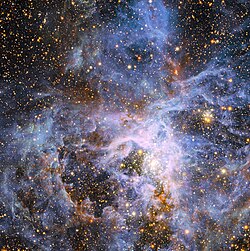VFTS 682
| في إف تي إس 682 | |
|---|---|
| معلومات الرصد حقبة J2000 اعتدالان J2000 |
|
| كوكبة | أبو سيف |
| مطلع مستقيم | 05سا 38د 55.51ث[1] |
| الميل | −69° 04′ 26.72″[1] |
| القدر الظاهري (V) | 16.08[2] |
| الخصائص | |
| نوع الطيف | WN5h[3] |
| U−B مؤشر اللون | -0.349[4] |
| B−V مؤشر اللون | -0.58[2] |
| القياسات الفلكية | |
| السرعة الشعاعية (Rv) | 300[5] كم/ث |
| البعد | 164,000 س.ض |
| القدر المطلق (MV) | -6.83±0.12[5] |
| القدر البولومتري المطلق (Mbol) |
-11.5 |
| تفاصيل | |
| كتلة | 150[5] ك☉ |
| نصف قطر | 22[5] نق☉ |
| إضاءة | 3.2 million[5] ض☉ |
| إضاءة (مرئي , ض م) | 43,000 ض☉ |
| درجة الحرارة | 52,200±2,500[5] ك |
| دوران | <200[6] |
| عمر | 1-1.4 million[5] سنة |
| تسميات اخرى | |
| مسح ميكروي ثنائي لكامل السماء J05385552-6904267, مرصد جنوب إفريقيا الفلكي J05385552-6904267, DENIS J053855.4-690425, DENIS J053855.5-690426, Dor IRS 153 | |
| قاعدة بيانات المراجع | |
| سيمباد | بيانات |
| تعديل مصدري - تعديل | |
في إف تي إس 682 في علم الفلك (بالإنجليزية: VFTS 682 ) هو أحد النجوم كبيرة الكتلة المعروفة حتى الآن. وتقدر كتلته بنحو 150 M☉ (150 كتلة شمسية ) , ويقدر العلماء أن كتلته في السابق كانت تصل إلى نحو 210 كتلة شمسية . يعتبر النجم VFTS 682 من نوع نجم وولف-رايت وينتمي تصنيفه الطيفي بالتصنيف WN5h.[7]
يقع النجم VFTS 682 على مسافة تقدر بنحو 30 فرسخ فلكي شمال شرق التجمع النجمي آر136 ، يبعد عنا نحو 150.000 سنة ضوئية.[8] الموجود في سديم العنكبوت (دورادو 30) في سحابة ماجلان الكبرى.
يطرح مكانه المعزول وكتلته العظيمة سؤالا، وهو كيف تكوّن هذا النجم الكبير، هل كان ذلك في مكانه الحالي أو كان في السابق من ضمن التجمع النجمي آر136 (تجمع نجمي).[7][9]
الخصائص التالية ترجح نشأة هذا النجم في مكانه الحالي :[9]
- مكانه منعزل
- حركته بسيطة
- عدم وجود صدمة مقدمة bow shock
ومن جهة أخرى كان يعتقد ان تلك النجوم كبيرة الكتلة تتكون فقط في وسط تجمعات نجمية . .[10] فهناك يمكن التحام نجوم من أنظمة نجم ثنائي ؛ وهذا ما تنتجه حسابات المحاكاة التي يجريها العلماء بواسطة الحواسيب الكبيرة.[11]
المراجع
[عدل]- ^ ا ب Cutri، R. M.؛ Skrutskie، M. F.؛ Van Dyk، S.؛ Beichman، C. A.؛ Carpenter، J. M.؛ Chester، T.؛ Cambresy، L.؛ Evans، T.؛ Fowler، J.؛ Gizis، J.؛ Howard، E.؛ Huchra، J.؛ Jarrett، T.؛ Kopan، E. L.؛ Kirkpatrick، J. D.؛ Light، R. M.؛ Marsh، K. A.؛ McCallon، H.؛ Schneider، S.؛ Stiening، R.؛ Sykes، M.؛ Weinberg، M.؛ Wheaton، W. A.؛ Wheelock، S.؛ Zacarias، N. (2003). "VizieR Online Data Catalog: 2MASS All-Sky Catalog of Point Sources (Cutri+ 2003)". VizieR On-line Data Catalog: II/246. Originally published in: 2003yCat.2246....0C. ج. 2246. Bibcode:2003yCat.2246....0C.
- ^ ا ب Evans، C. J.؛ Taylor، W. D.؛ Hénault-Brunet، V.؛ Sana، H.؛ De Koter، A.؛ وآخرون (يونيو 2011). "The VLT-FLAMES Tarantula Survey. I. Introduction and observational overview". Astronomy & Astrophysics. ج. 530: A108. arXiv:1103.5386. Bibcode:2011A&A...530A.108E. DOI:10.1051/0004-6361/201116782.
- ^ Bressert، E.؛ Bastian، N.؛ Evans، C. J.؛ Sana، H.؛ Hénault-Brunet، V.؛ وآخرون (يونيو 2012). "The VLT-FLAMES Tarantula Survey. IV. Candidates for isolated high-mass star formation in 30 Doradus". Astronomy & Astrophysics. ج. 542: A49. arXiv:1204.3628. Bibcode:2012A&A...542A..49B. DOI:10.1051/0004-6361/201117247.
- ^ Parker، Joel Wm. (1992). "30 Doradus in the Large Magellanic Cloud: The Stellar Content and Initial Mass Function". Publications of the Astronomical Society of the Pacific. ج. 104: 1107. Bibcode:1992PASP..104.1107P. DOI:10.1086/133097.
- ^ ا ب ج د ه و ز Bestenlehner، J. M.؛ Vink، J. S.؛ Gräfener، G.؛ Najarro، F.؛ Evans، C. J.؛ وآخرون (يونيو 2011). "The VLT-FLAMES Tarantula Survey. III. A very massive star in apparent isolation from the massive cluster R136". Astronomy & Astrophysics. ج. 530: L14. arXiv:1105.1775. Bibcode:2011A&A...530L..14B. DOI:10.1051/0004-6361/201117043.
- ^ Bestenlehner، J. M.؛ Gräfener، G.؛ Vink، Jorick S.؛ Najarro، F.؛ De Koter، A.؛ وآخرون (أكتوبر 2014). "The VLT-FLAMES Tarantula Survey. XVII. Physical and wind properties of massive stars at the top of the main sequence". Astronomy & Astrophysics. ج. 570: A38. arXiv:1407.1837. Bibcode:2014A&A...570A..38B. DOI:10.1051/0004-6361/201423643.
- ^ ا ب اكتب عنوان المرجع بين علامتي الفتح
<ref>والإغلاق</ref>للمرجعaa1 - ^ Joachim M. Bestenlehner, S.2 "projected distance approximately 30 pc northeast of R136"
- ^ ا ب اكتب عنوان المرجع بين علامتي الفتح
<ref>والإغلاق</ref>للمرجعaa2 - ^ Joachim M. Bestenlehner, S.1 "seem to link the formation of such objects to environments in the centres of massive clusters"
- ^ Sambaran Banerjee, S.10 "such massive binary mergers can easily produce single stars, within a few Myr, with masses well exceeding the 150 M☉ upper limit"
- ^ Joachim M. Bestenlehner, Jorick S. Vink, G. Gr̈afener, F. Najarro et. aliis (11 May 2011). "The VLT-FLAMES Tarantula Survey III: A very massive star in apparent isolation from the massive cluster R136*" (PDF 786 KB S.1 (1)) (بالإنجليزية). مجلة علم الفلك والفيزياء الفلكية (AA) manuscript no. 17043. Retrieved 2015-02-24.
{{استشهاد ويب}}: صيانة الاستشهاد: أسماء متعددة: قائمة المؤلفين (link) - ^ Sambaran Banerjee, Pavel Kroupa, Seungkyung Oh (1 Nov 2011). "Runaway massive stars from R136: VFTS 682 is very likely a "slow runaway"" (PDF 443 KB S.2 (2)) (بالإنجليزية). Argelander-Institut für Astronomie. Retrieved 2015-02-24.
{{استشهاد ويب}}: صيانة الاستشهاد: أسماء متعددة: قائمة المؤلفين (link) - ^ C.J. Evans, W.D. Taylor, V. Hénault-Brunet, H. Sana et. aliis (26 Mar 2011). "A&A 530, A108 (2011) The VLT-FLAMES Tarantula Survey" (PDF 6 MB S.32 (32)) (بالإنجليزية). Astronomy and Astrophysics. Retrieved 2015-02-24.
{{استشهاد ويب}}: صيانة الاستشهاد: أسماء متعددة: قائمة المؤلفين (link) - ^ "VLT-FLAMES Tarantula Survey" (بالإنجليزية). The Royal Observatory, Edinburgh. Retrieved 2015-02-24.
